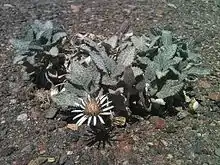Urmenetea
Urmenetea is a genus of South American plants in the family Asteraceae.[1][2][3]
- Species
| Urmenetea | |
|---|---|
 | |
| Scientific classification | |
| Kingdom: | Plantae |
| Clade: | Tracheophytes |
| Clade: | Angiosperms |
| Clade: | Eudicots |
| Clade: | Asterids |
| Order: | Asterales |
| Family: | Asteraceae |
| Subfamily: | Mutisioideae |
| Tribe: | Onoserideae |
| Genus: | Urmenetea Phil. |
| Species: | U. atacamensis |
| Binomial name | |
| Urmenetea atacamensis | |
| Synonyms | |
|
Onoseris atacamensis (Phil.) Hoffmann | |
The only known species is Urmenetea atacamensis, native to northern Chile (Antofagasta, Atacama) and northern Argentina (Catamarca, Jujuy, Salta).[4][5][6]
- Uses
According to "Enzyklopädie der Psychoaktiven Pflanzen", natives of the atacama desert use the plant for its psychoactive properties. When chewing the leaves, Dr.phil Christian Rätsch reported a sensation of local anestesia and a general feeling of euphoria and stimulation, akin to the effects of chewing coca leaves. Smoked injestion may result in both narcotic and stimulant effects. "Enzyklopädie der Psychoactiven Pflanzen" lists 0.3g of dried leaves as a sufficient dosage. Nothing is known about the chemical properties of the active ingredient and its dangers.
References
- Philippi, Rudolf Amandus. 1860. Florula Atacamensis seu enumeration page 26
- Tropicos, Urmenetea Phil.
- Philippi, Rudolf Amandus. 1860. Viage al Desierto de Atacama 201
- Flann, C (ed) 2009+ Global Compositae Checklist
- Cabrera, A. L. 1978. Compositae. 10: 1–726. In A. L. Cabrera (ed.) Flora de la provincia de Jujuy. Instituto Nacional de Tecnología Agropecuaria, Buenos Aires.
- Marticorena, C. & M. Quezada. 1985. Catálogo de la Flora Vascular de Chile. Gayana, Botánica 42: 1–157